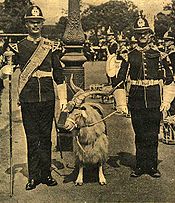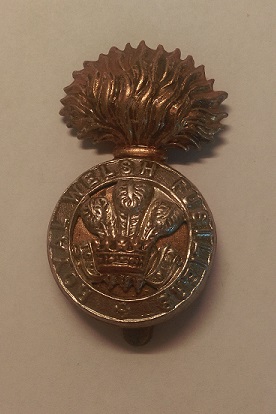
The Royal Welch Fusiliers (Welsh: Ffiwsilwyr Brenhinol Cymreig) was a line infantry regiment of the British Army, and part of the Prince of Wales' Division, that was founded in 1689; shortly after the Glorious Revolution. In 1702, it was designated a fusilier regiment and became the Welch Regiment of Fusiliers; the prefix "Royal" was added in 1713, then confirmed in 1714 when George I named it the Prince of Wales's Own Royal Regiment of Welsh Fusiliers. In 1751, after reforms that standardised the naming and numbering of regiments, it became the 23rd Regiment of Foot (Royal Welsh Fuzileers). In 1881, the final title of the regiment was adopted.

A mascot is any human, animal, or object thought to bring luck, or anything used to represent a group with a common public identity, such as a school, sports team, society, military unit, or brand name. Mascots are also used as fictional, representative spokespeople for consumer products.

Whipsnade Zoo, formerly known as ZSL Whipsnade Zoo and Whipsnade Wild Animal Park, is a zoo and safari park located at Whipsnade, near Dunstable in Bedfordshire, England. It is one of two zoos that are owned by the Zoological Society of London (ZSL), a charity devoted to the worldwide conservation of animals and their habitats.
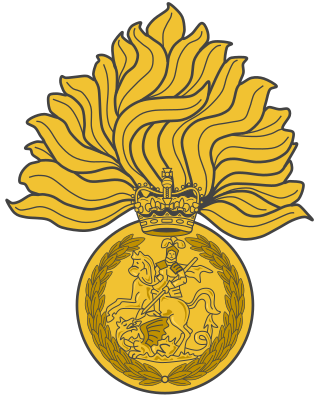
The Royal Regiment of Fusiliers is an infantry regiment of the British Army, part of the Queen's Division. Currently, the regiment has two battalions: the 1st Battalion, part of the Regular Army, is an armoured infantry battalion based in Tidworth, Wiltshire, and the 5th Battalion, part of the Army Reserve, recruits in the traditional fusilier recruiting areas across England. The Royal Regiment of Fusiliers was largely unaffected by the infantry reforms that were announced in December 2004, but under the Army 2020 reduction in the size of the Army, the 2nd Battalion was merged into the first in 2014.

The Great Orme is a limestone headland on the north coast of Wales, north-west of the town of Llandudno. Referred to as Cyngreawdr Fynydd by the 12th-century poet Gwalchmai ap Meilyr, its English name derives from the Old Norse word for sea serpent. The Little Orme, a smaller but very similar limestone headland, is on the eastern side of Llandudno Bay.

"Other ranks" is the term used to refer to all ranks below officers in the British Army and the Royal Marines. It includes warrant officers, non-commissioned officers ("NCOs") and ordinary soldiers with the rank of private or regimental equivalent. Officers may, in speaking, distinguish themselves from those "in the ranks".

The Mercian Regiment is an infantry regiment of the British Army, which is recruited from five of the counties that formed the ancient kingdom of Mercia. Known as 'The Heart of England's Infantry', it was formed on 1 September 2007 by the amalgamation of three existing regiments. The Regiment has had fifteen operational deployments since its formation.

The Royal Welsh is an armoured infantry regiment of the British Army. It was established in 2006 from the Royal Welch Fusiliers and the Royal Regiment of Wales.
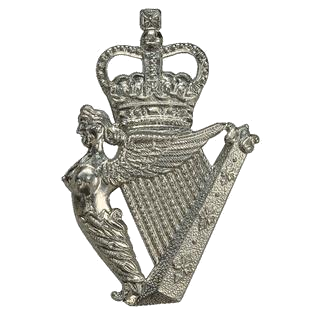
The Royal Irish Regiment is an infantry regiment of the British Army. The regiment was founded in 1992 through the amalgamation of the Royal Irish Rangers and the Ulster Defence Regiment. Their oldest predecessor, the 27th Regiment of Foot, was first raised in June 1689 to fight in the Williamite War in Ireland. Other notable regiments in their lineage include the Royal Inniskilling Fusiliers, Royal Irish Rifles and the Royal Irish Fusiliers.

1st The Queen's Dragoon Guards (QDG) is a regiment in the Royal Armoured Corps of the British Army. Nicknamed The Welsh Cavalry, the regiment recruits from Wales and the bordering English counties of Cheshire, Herefordshire, and Shropshire, and is the senior cavalry regiment, and therefore senior regiment of the line of the British Army.
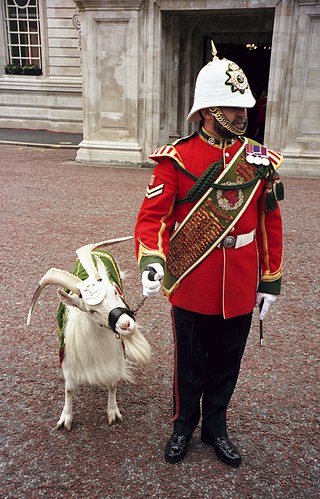
The Royal Regiment of Wales was an infantry regiment of the British Army, part of the Prince of Wales' Division. It was formed in 1969 by the amalgamation of the South Wales Borderers and the Welch Regiment. The 1st Battalion, The Royal Regiment of Wales had a short existence in military terms, just over 36 years. Within two months of amalgamation, the battalion was one of the first units to be deployed to Northern Ireland.
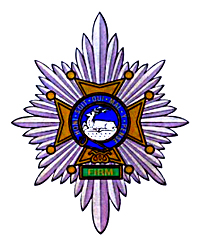
The Worcestershire and Sherwood Foresters Regiment was an infantry regiment of the British Army, part of the Prince of Wales' Division. The regiment served as the county regiment for Derbyshire, Nottinghamshire and Worcestershire.
The Royal Irish Rangers was a regular infantry regiment of the British Army with a relatively short existence, formed in 1968 and later merged with the Ulster Defence Regiment in 1992 to form the Royal Irish Regiment.
The Royal Welsh Regiment was an infantry regiment of the Territorial Army in the United Kingdom. It existed from 1999, until it was re-designated as the 3rd Battalion, The Royal Welsh in 2006.

The Queen's Division is a British Army training and administrative apparatus for infantry regiments from the East & South of England, and Gibraltar.

The Royal Regiment of Scotland is the senior and only Scottish line infantry regiment of the British Army Infantry. It consists of three regular and two reserve battalions, plus an incremental company, each formerly an individual regiment. However, three regular battalions maintain their former regimental pipes and drums to carry on the traditions of their antecedent regiments.

A military mascot, also known as a ceremonial pet or regimental mascot, is a pet animal maintained by a military unit as a mascot for ceremonial purposes and/or as an emblem of that unit. It differs from a military animal in that it is not employed for use directly in warfare as a weapon or for transport.
The Welsh Horse Yeomanry was a yeomanry regiment of the British Army that served in the First World War. The regiment was raised shortly after the outbreak of the war. Initially it served in East Anglia on anti-invasion duties, before being dismounted in 1915 and sent to take part in the Gallipoli Campaign. After withdrawal to Egypt, it was amalgamated with the 1/1st Montgomeryshire Yeomanry as the 25th Battalion, Royal Welch Fusiliers and served as such throughout the rest of the war. It took part in the Sinai and Palestine Campaign in 1917 and 1918, before being transferred to the Western Front where it remained until the end of the war. The regiment formed 2nd and 3rd Lines in 1914, but these never left the United Kingdom before being disbanded in 1916 and early 1917, respectively. The 1st Line was disbanded in 1919.
The 1915 Birthday Honours were appointments by King George V to various orders and honours to reward and highlight good works by citizens of the British Empire. The appointments were made to celebrate the official birthday of The King, and were published in The London Gazette and in The Times on 3 June 1915.

